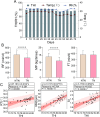Metagenomic analysis reveals microbial drivers of heat resistance in dairy cattle
- PMID: 40205588
- PMCID: PMC11984055
- DOI: 10.1186/s42523-025-00399-8
Metagenomic analysis reveals microbial drivers of heat resistance in dairy cattle
Abstract
Heat stress poses a significant challenge to dairy cattle, leading to adverse physiological effects, reduced milk yield, impaired reproduction performance and economic losses. This study investigates the role of the rumen microbiome in mediating heat resistance in dairy cows. Using the entropy-weighted TOPSIS method, we classified 120 dairy cows into heat-resistant (HR) and heat-sensitive (HS) groups based on physiological and biochemical markers, including rectal temperature (RT), respiratory rate (RR), salivation index (SI) and serum levels of potassium ion (K+), heat shock protein 70 (HSP70) and cortisol. Metagenomic sequencing of rumen fluid samples revealed distinct microbial compositions and functional profiles between the two groups. HR cows exhibited a more cohesive and functionally stable microbiome, dominated by taxa such as Ruminococcus flavefaciens and Succiniclasticum, which are key players in fiber degradation and short-chain fatty acid production. Functional analysis highlighted the enrichment of the pentose phosphate pathway (PPP) in HR cows, suggesting a metabolic adaptation that enhances oxidative stress management. In contrast, HS cows showed increased activity in the tricarboxylic acid (TCA) cycle, pyruvate metabolism and other energy-intensive pathways, indicating a higher metabolic burden under heat stress. These findings underscore the critical role of the rumen microbiome in modulating heat resistance and suggest potential microbiome-based strategies for improving dairy cattle resilience to climate change.
Keywords: Ruminococcus flavefaciens; Dairy cattle; Heat resistance; Pentose phosphate pathway; Rumen microbiome.
© 2025. The Author(s).
Conflict of interest statement
Declarations. Ethics approval and consent to participate: All procedures in this experiment were conducted according to the Animal Protection Law based on the Guide for the Care and Use of Laboratory Animals approved by the Ethics Committee of Yangzhou University. Consent for publication: Not applicable. Competing interests: The authors declare no competing interests.
Figures







Similar articles
-
Live yeast supplementation altered the bacterial community's composition and function in rumen and hindgut and alleviated the detrimental effects of heat stress on dairy cows.J Anim Sci. 2023 Jan 3;101:skac410. doi: 10.1093/jas/skac410. J Anim Sci. 2023. PMID: 36534956 Free PMC article.
-
Modulation of rumen fermentation and microbial community through increasing dietary cation-anion difference in Chinese Holstein dairy cows under heat stress conditions.J Appl Microbiol. 2021 Mar;130(3):722-735. doi: 10.1111/jam.14812. Epub 2020 Aug 28. J Appl Microbiol. 2021. PMID: 32757409
-
Heat Stress: Effects on Rumen Microbes and Host Physiology, and Strategies to Alleviate the Negative Impacts on Lactating Dairy Cows.Front Microbiol. 2022 Feb 28;13:804562. doi: 10.3389/fmicb.2022.804562. eCollection 2022. Front Microbiol. 2022. PMID: 35295316 Free PMC article. Review.
-
Novel insights into heat tolerance using metabolomic and high-throughput sequencing analysis in dairy cows rumen fluid.Animal. 2022 Mar;16(3):100478. doi: 10.1016/j.animal.2022.100478. Epub 2022 Mar 2. Animal. 2022. PMID: 35247705
-
Graduate Student Literature Review: Potential use of HSP70 as an indicator of heat stress in dairy cows-A review.J Dairy Sci. 2024 Dec;107(12):11597-11610. doi: 10.3168/jds.2024-24947. Epub 2024 Aug 31. J Dairy Sci. 2024. PMID: 39218068 Review.
References
-
- North MA, Franke JA, Ouweneel B, et al. Global risk of heat stress to cattle from climate change. Environ Res Lett. 2023;18(9):094027.
-
- Mishra SR. Behavioural, physiological, neuro-endocrine and molecular responses of cattle against heat stress: an updated review. Trop Anim Health Prod. 2021;53(3):400. - PubMed
-
- Hamel J, Zhang Y, Wente N, et al. Heat stress and cow factors affect bacteria shedding pattern from naturally infected mammary gland quarters in dairy cattle. J Dairy Sci. 2021;104(1):786–94. - PubMed
-
- Menta PR, Machado VS, Piñeiro JM, et al. Heat stress during the transition period is associated with impaired production, reproduction, and survival in dairy cows. J Dairy Sci. 2022;105(5):4474–89. - PubMed
Grants and funding
LinkOut - more resources
Full Text Sources
